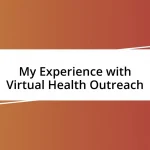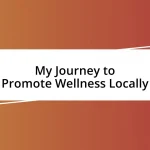Key takeaways:
- Effective public health messaging connects emotionally, using relatable stories and culturally relevant content to engage the audience and build trust.
- Utilizing social media facilitates dynamic dialogues and fosters community involvement, making messaging authentic and interactive.
- Continuous evaluation of messaging impact through qualitative and quantitative methods allows for real-time adjustments, enhancing the effectiveness of public health campaigns.

Understanding Public Health Messaging
Public health messaging isn’t just about disseminating information; it’s about connecting with people on an emotional level. I recall a time when a community health initiative aimed to reduce smoking rates. They didn’t just share statistics on lung cancer; they told stories of individuals whose lives were forever changed by smoking. This approach resonated deeply with the audience, illustrating how relatable messages can spark real change.
When I think about effective public health messaging, I often ask myself: What truly makes a message stick? In my experience, clarity is crucial, but so is the tone. For example, a campaign that used humor to address mental health destigmatized the conversation, allowing people to feel safe discussing their struggles. That highlights how the right tone isn’t just about being professional; it’s about being approachable and human.
I’ve also seen how cultural relevance amplifies public health initiatives. In one project, the messaging was tailored to resonate with specific cultural communities, using familiar idioms and references. The response was overwhelmingly positive. It made me realize how understanding your audience, their values, and their fears can transform public health outcomes. Isn’t it fascinating how much impact thoughtful communication can have on community health?
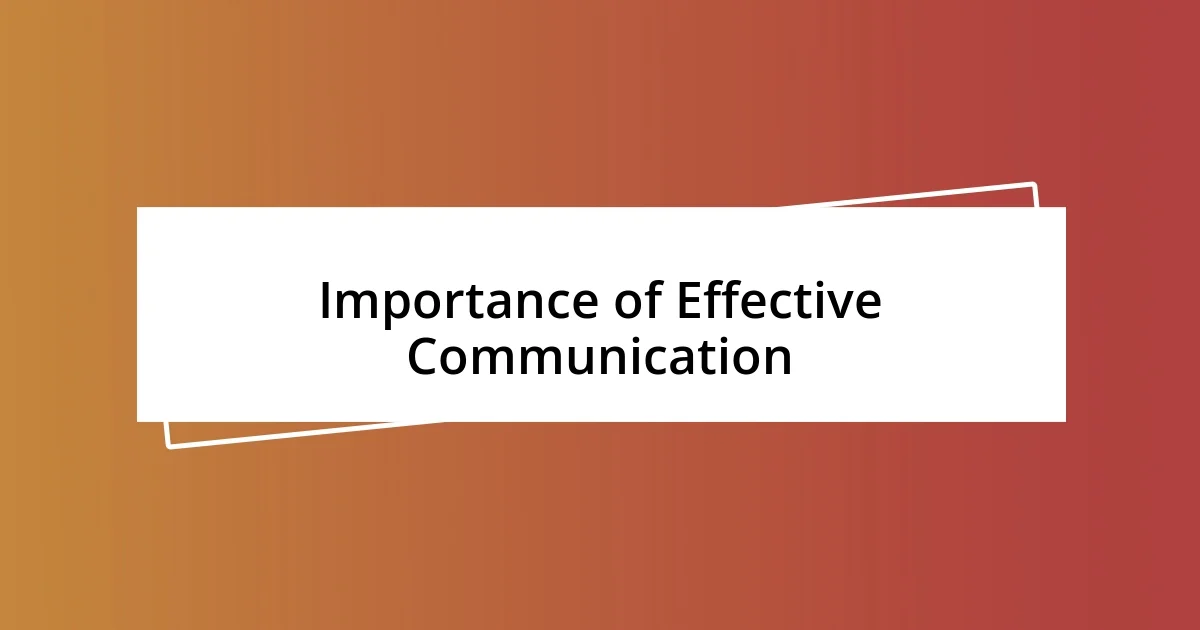
Importance of Effective Communication
Effective communication in public health is a game changer. I remember a vaccination campaign that focused not just on the facts but on people’s fears. By addressing worries about vaccine safety directly and empathetically, they invited open conversations, allowing community members to voice their concerns. This approach led to higher vaccination rates than the traditional methods, demonstrating that when communication is thoughtful, it cultivates trust.
I often ponder how people remember information. In my experience, repetitive, compelling messaging creates resonance. For instance, a campaign I worked on used visual storytelling to illustrate community health improvements over time. The powerful images and consistent messaging left an imprint, encouraging individuals to engage with health services more actively. It’s a reminder that effective communication transforms statistics into stories that motivate action.
When it comes to public health, listening is as important as speaking. Once, I joined a community feedback session for a health program. Hearing firsthand accounts allowed me to understand the gaps in our messaging. People responded more readily to campaigns that included their voices and experiences. This fosters a sense of ownership and shared purpose, reinforcing that effective communication is a dialogue, not a monologue.
| Effective Communication | Ineffective Communication |
|---|---|
| Engages with emotions | Is purely factual |
| Builds trust | Creates skepticism |
| Encourages dialogue | Promotes silence |
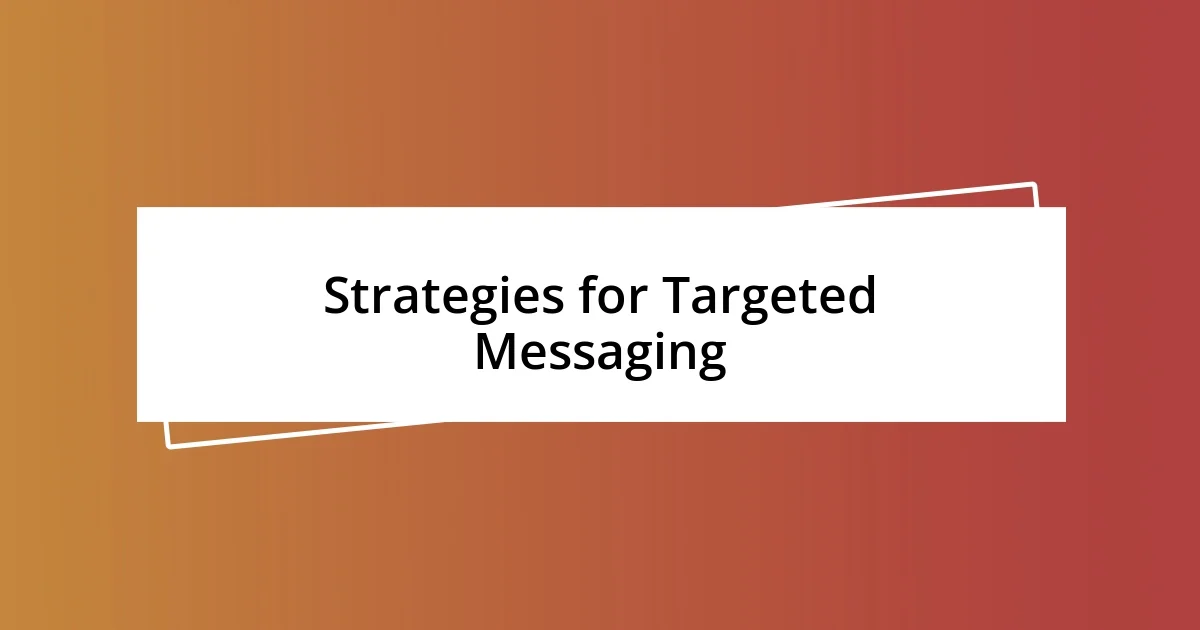
Strategies for Targeted Messaging
When I reflect on effective strategies for targeted messaging, I often find that segmentation is key. Dividing the audience into specific groups allows for tailoring messages that resonate deeply. For example, I once worked on a campaign aimed at increasing physical activity among seniors. We created messages that emphasized community involvement and social interaction. By focusing on the benefits of group activities, we transformed a simple health initiative into an opportunity for connection and joy.
To further enhance targeted messaging, consider these strategies:
- Utilize data analytics: Understand demographics and behaviors to refine your approach.
- Leverage social media: Engage different audience segments with tailored content based on their interests.
- Incorporate testimonials: Real stories from relatable individuals can create powerful connections.
- Adjust the format: Use various formats, like videos or infographics, to cater to different learning styles and preferences.
- Test and iterate: A/B testing can reveal which messages resonate best, allowing continuous improvement.
By implementing these strategies, I’ve observed that campaigns become more impactful, leading to healthier communities. It’s all about meeting people where they are.

Utilizing Social Media for Outreach
Social media has emerged as a powerful tool for public health outreach, enabling us to connect with diverse audiences quickly. I recall a time when we launched a campaign on mental health awareness, leveraging platforms like Instagram and TikTok to reach younger demographics. By creating short, engaging video content with relatable messaging, we were able to spark conversations and reduce stigma around mental health issues. Seeing individuals share their stories and experiences online was incredibly moving, underscoring the potential of social media as a safe space for discussion.
When crafting messages for social media, it’s essential to be authentic and interactive. During a campaign on nutrition, we created polls and quizzes on Twitter that invited followers to share their eating habits. The results were not only eye-opening but also fostered a sense of community. People felt that they were part of something bigger and were more likely to adopt healthier habits as a result. Isn’t it fascinating how digital engagement can blur the lines between expert and audience, creating a more dynamic dialogue?
To truly make an impact, timing and frequency of posts are crucial. I learned this firsthand during a flu vaccination drive. We scheduled posts leading up to the vaccination season, reinforcing urgency and providing helpful tips on where to get shots. By the time flu season arrived, our messaging was already ingrained in the community’s mind. This strategic use of social media not only raised awareness but directly contributed to increased vaccination uptake. Don’t you think it’s incredible how tailored content can shift public behavior?

Engaging Diverse Communities
Engaging diverse communities requires a nuanced approach that speaks to their unique experiences and needs. I once collaborated with a local health department aiming to promote HIV testing in a culturally diverse neighborhood. By organizing focus groups, we learned that many residents felt hesitant due to stigma and fear of discrimination. These insights shaped our messaging; we emphasized confidentiality and community support in our outreach, which really turned the tide. Isn’t it remarkable how a simple conversation can unveil barriers we might overlook?
In another project focused on childhood obesity, we partnered with schools in different communities to better understand the parents’ perspectives. By hosting workshops where parents could voice their concerns and preferences, we discovered that they valued practical, actionable advice that fit into their busy lives. This led us to create easy-to-implement meal planning guides that resonated with both parents and children, making healthy choices feel achievable. Have you ever noticed that when people feel heard, they are more likely to engage meaningfully?
Lastly, I’ve found that using culturally relevant imagery and language can substantially enhance outreach efforts. During a campaign addressing vaccine hesitancy among immigrant communities, we utilized graphics that showcased familiar faces and scenarios. This visual approach facilitated connection and made the information feel more applicable to their everyday lives. It felt powerful to see community members nodding in recognition of their own experiences. How often do we stop to think about the impact of representation in our messaging? It’s transformative.

Measuring the Impact of Messaging
Measuring the impact of public health messaging requires a blend of qualitative and quantitative approaches. I recall a project where we analyzed the effectiveness of a smoking cessation campaign through surveys and social media analytics. The data revealed that after our messaging, there was a significant increase in searches for local cessation resources, which was a clear indicator of change. Isn’t it fascinating how numbers can narrate a story of transformation?
Another method I’ve employed is collecting testimonials from individuals who engaged with our messaging. During a sexual health workshop, I noticed participants who were once quiet actively sharing their experiences after being exposed to our tailored content. Their feedback not only validated our efforts but also highlighted the importance of emotional connection in messaging. Have you ever considered how personal stories can amplify the reach of a message?
Lastly, I believe that continuous monitoring allows us to adjust our strategies in real-time. For instance, during a vaccination campaign, we employed tracking tools to evaluate engagement and sentiment. When we noticed a drop in interest, it prompted us to pivot our approach by incorporating more relatable visuals and success stories. Isn’t it empowering to realize that we can adapt and refine our efforts based on what resonates with the audience?
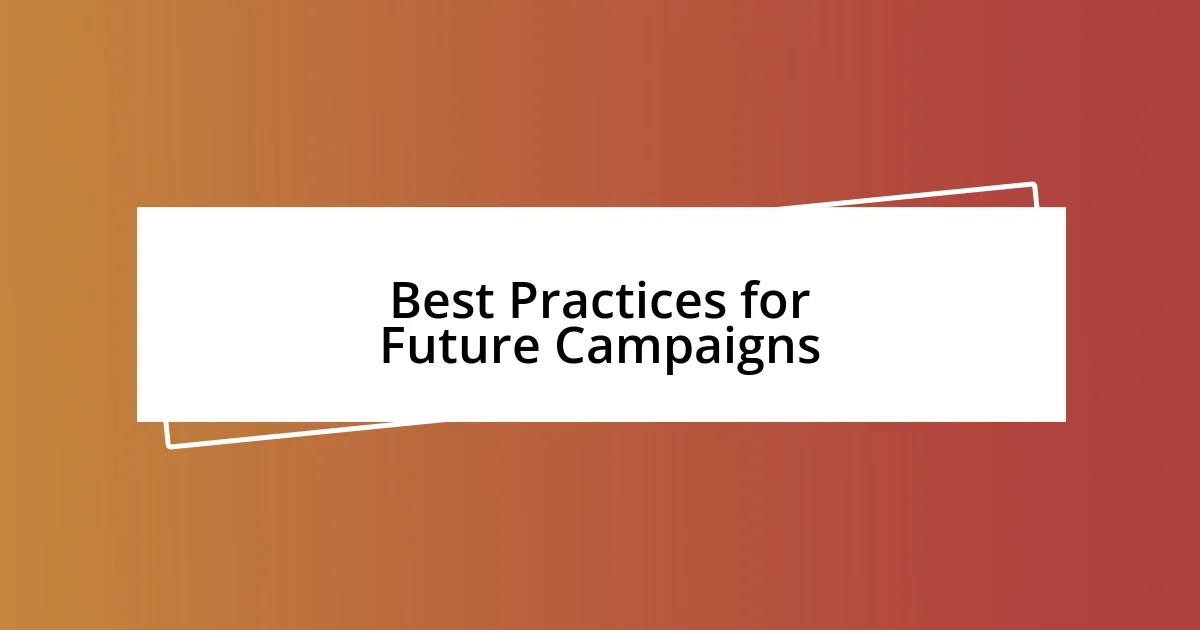
Best Practices for Future Campaigns
When crafting future public health campaigns, one of the best practices I’ve found is the importance of adaptability. In a recent initiative promoting mental health resources, we initially focused our messaging on the clinical aspects. However, feedback from community meetings revealed that many individuals preferred hearing stories of resilience and recovery. This shift not only made our campaign more relatable but also fostered a supportive environment for those struggling. Isn’t it incredible how simply tweaking our approach can resonate so much more deeply with an audience?
Another key practice is collaboration with trusted community leaders. I recall working with a respected local figure in a diabetes awareness campaign. Their endorsement transformed our outreach efforts, making it feel more authentic. When someone the community already trusts delivers the message, it’s more likely to be embraced. Have you ever noticed how personal connections can amplify the credibility of health messaging?
Finally, utilizing varied platforms is essential for reaching diverse audiences effectively. I once assisted in a campaign targeting young adults about safe sex practices. We created short, engaging content for social media, alongside in-depth resources for those seeking more information. This dual approach not only met people where they were but also honored their learning preferences. Isn’t it fascinating how a tailored media strategy can engage different segments of a community?













